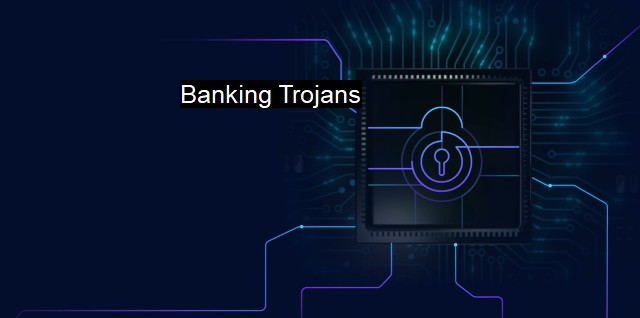What are Banking Trojans?
Understanding Banking Trojans: The Malware Behind Financial Loss and Fraud in the Digital Age
Banking Trojans, as the name implies, are malicious software primarily designed to steal sensitive information from systems used in online banking and financial transactions. Known for their stealth and disguise, they majorly affect individuals and banks, with a devastating impact on institutions due to the massive volumes of transactions they handle daily. they significantly undermine the confidence of customers in the security of online banking platforms.Banking Trojans can be particularly insidious, often working silently in the background of the victim's device without interference to the regular operations. Like the mythical famous Greek "Trojan Horse," this malware tends to deceive users into loading them on their systems. This subterfuge capability is what distinguishes them, making them a severe threat in cybersecurity.
The primary modus operandi of banking Trojans involves posing as genuine software or being embedded in legitimate-looking apps and files. They trick users into clicking or downloading them onto their systems. Once inside, they stealthily start transmitting users' confidential data to the attacker's servers. They monitor and record keyboard strokes (keylogging), which enables them to acquire login credentials. What is concerning is that these Trojans are designed to bypass the typical user authentication processes employed while accessing banking platforms.
Many Banking Trojans are equipped to alter user transactions subtly. A user might validate a certain transaction amount, but the Trojan would manipulate the data and execute a different transaction while displaying the original value to the user.
The evolution and sophistication of Banking Trojans are a pressing concern. Advancements in their capabilities have enabled them to intercept OTPs (One Time Password) sent to mobile devices, thus combating the second layer of security many banks employ. The infamous "Emotet" Trojan went beyond banks and started hitting other targets with profitable personal data.
In such a grim scenario with severe security implications, effective combating methods have become essential. In this regard, the foremost solution that stands out is antivirus software. These software programs are configured to detect, restrict, and eliminate potentially harmful malware, including Banking Trojans.
Modern antivirus programs come furnished with real-time protection, scanning every file that is operated. These tools can identify the signature and behavior of known malware. They also offer heuristics analysis for diagnosing unknown threats, detecting abnormalities or patterns synonymous with malware.
Considering the rising sophistication of Banking Trojans, relying solely on traditional antivirus solutions may not be sufficient. Implementation of multi-factor authentication (MFA) in online banking portals significantly reduces the chances of data theft. It introduces an additional security layer, requiring more than one form of authentication, making it much harder for Trojans to bypass.
Regular software updates on user devices play a critical role in preventing malware attacks. These updates invariably include patches that fix vulnerabilities that could be exploited by Trojans. Better internet habits, like avoiding unknown links or websites, careful downloading, and use of robust and unique passwords, can make substantial contributions to cybersecurity hygiene.
Discussions around Banking Trojans serve as a reminder of the dynamic nature of cybersecurity threats, making constant vigilance and improvements in security systems imperative. As technology continues to advance, so do the techniques used by cybercriminals. Therefore, the onus lies on both stakeholders - the institutions and the individuals to foster a secure online banking environment. Combining regular education about potential threats with a robust antivirus system and secure habits should put us on a solid path towards foolproof security. The fight against cybercrime is ongoing, but with the right knowledge and tools, we can certainly gain the upper hand against threats like Banking Trojans.

Banking Trojans FAQs
What is a banking Trojan?
A banking Trojan is a type of malware that is specifically designed to steal confidential information from victim's computer systems such as online banking credentials, credit card details or other sensitive data, usually for financial gain.How do banking Trojans infect computers?
Banking Trojans typically spread via email attachments or malicious links, infected websites, or a fake software update. Once the computer is infected, the Trojan can steal sensitive information without the user's knowledge.How can I protect myself from banking Trojans?
To protect yourself from banking Trojans, you should use antivirus software and keep it up to date. You should also avoid clicking on suspicious links or downloading attachments from unknown sources. Additionally, you should enable two-factor authentication, regularly change your passwords and monitor your online accounts for any unusual activity.What should I do if I suspect that my computer is infected with a banking Trojan?
If you suspect that your computer is infected with a banking Trojan, you should immediately disconnect from the internet and run a full virus scan using a reputable antivirus program. You should also change all of your passwords and contact your bank to check for any unauthorized transactions. It is also advisable to seek help from a cybersecurity professional to ensure that the Trojan has been completely removed from your computer.| | A | | | B | | | C | | | D | | | E | | | F | | | G | | | H | | | I | | | J | | | K | | | L | | | M | |
| | N | | | O | | | P | | | Q | | | R | | | S | | | T | | | U | | | V | | | W | | | X | | | Y | | | Z | |
| | 1 | | | 2 | | | 3 | | | 4 | | | 7 | | | 8 | | |||||||